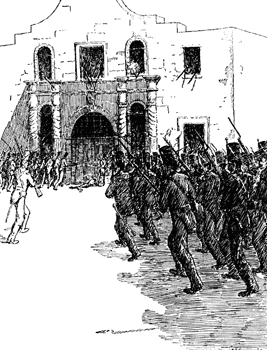|
Micajah Autry Micajah Autry is reputedly a native of Sampson County, North Carolina. After serving as a soldier in the War of 1812, he took up literary pursuits and teaching. He moved to Hayesboro, Tennessee in 1823, where he studied law and was admitted to the bar in Nashville in 1828 or 1829. In 1831, he moved to Jackson, Tennessee, where he practiced law until 1835 when he volunteered to help defend the Alamo and met the same death as the other defenders. [Source: North Carolina newspaper obituary quoted in Aédle B. Looscan, "Micajah Autry, A Soldier of the Alamo," Southwestern Historical Quarterly] "During business trips to New York and Philadelphia, he heard of opportunities in Texas. In 1835 he left his family and slaves in the care of Samuel Smith, his stepdaughter's husband, and set out for Texas by steamboat from Nashville, Tennessee. By January 14, 1836, he was in Nacogdoches, where he enlisted in the Volunteer Auxiliary Corps of Texas. His correspondence indicates that he set out for Washington-on-the-Brazos with David Crockett and others under the command of Capt. William B. Harrison. He arrived in Bexar with his company on or about February 9, 1836, and entered the Alamo with the garrison under the command of Lt. Col. William B. Travis on February 23. He died in the battle of the Alamo on March 6, 1836." [Micajah Autry — Handbook of Texas Online] [William Daniel Cloud (1814-1836), a native of Kentucky, and a lawyer, died at the Alamo with his fellow lawyer, Autry.] Micajah Autry Letters from the Alamo: Micajah Autry
The Fall of the Alamo [Used with permission of the Florida Center for Instructional Technology] Bibliography Amelia W. Williams, A Critical Study of the Siege of the Alamo and of the Personnel of Its Defenders (Ph.D. dissertation, University of Texas, 1931) Aédle B. Looscan, Micajah Autry, A Soldier of the Alamo, 14 Southwestern Historical Quarterly 315 (1911) [online text] |
